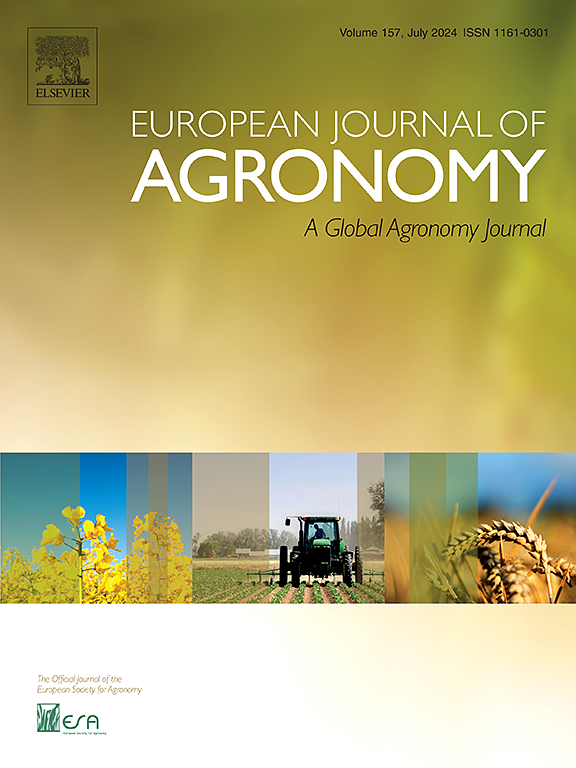利用 CARAIB 动态植被模型分析大气二氧化碳施肥对摩洛哥谷物产量的影响。
IF 4.5
1区 农林科学
Q1 AGRONOMY
引用次数: 0
摘要
气候变化和大气中二氧化碳含量的上升是影响农业生产力的关键因素,特别是在摩洛哥,谷类作物对粮食安全至关重要。本研究的主要目的是利用 CARAIB 动态植被模型,评估大气二氧化碳变化和气候变化对 2099 年前谷物产量的综合影响。该评估由欧洲-CORDEX 计划的区域气候模型在代表性浓度途径 8.5 下的四种未来情景驱动。作为评估的一部分,该研究还验证了摩洛哥主要谷物作物:软质小麦、硬质小麦和大麦的 CARAIB 模型,以确保该模型在预测环境条件下模拟作物反应的准确性。CARAIB 模型有效模拟了 2000 年至 2016 年摩洛哥主要农业地区谷物的历史产量轨迹,证明了其强大的预测能力。我们对未来的预测表明,二氧化碳水平的升高最初可能会使谷物产量维持在目前水平的约 90%,直到 2050 年。这一趋势表明,大气中二氧化碳的增加可能会缓和其他环境压力因素对作物产量的负面影响。然而,尽管有这种初始缓冲作用,但从现在到 2099 年的总体产量趋势表明,即使有二氧化碳施肥效应,大多数作物、区域和气候模型组合的产量也会下降,只有在某些情况下,模型显示产量略有增加或趋于稳定。此外,CARAIB 模型预测,从 2080 年代起,主要由于周期性干旱,产量可能会比当前水平低 10-35%。这种变化凸显了二氧化碳施肥与气候变化之间相互作用的复杂性,强调摩洛哥迫切需要制定适应性农业战略,以应对气候挑战,实现长期可持续性。本文章由计算机程序翻译,如有差异,请以英文原文为准。
Atmospheric CO2 fertilization effect on cereal yields in Morocco using the CARAIB dynamic vegetation model.
Climate change and rising atmospheric CO2 levels are critical factors influencing agricultural productivity, particularly in Morocco, where cereal crops are essential for food security. The primary objective of this study is to evaluate the combined effects of atmospheric CO2 variations and climatic changes on cereal yields up to 2099 using the CARAIB dynamic vegetation model. This evaluation is driven by four future scenarios based on the Euro-CORDEX initiative's regional climate models under the Representative Concentration Pathway 8.5. As part of this evaluation, the study also validates the CARAIB model for Morocco’s major cereal crops: soft wheat, durum wheat, and barley, in order to ensure the model's accuracy in simulating crop responses under projected environmental conditions. The CARAIB model effectively simulated historical cereal yield trajectories across major farming regions in Morocco from 2000 to 2016, demonstrating its robust predictive capability. Our future projections suggest that elevated CO2 levels might initially sustain cereal yields at approximately 90 % of current levels until 2050. This trend indicates that the increase in atmospheric CO2 may exert a moderating influence on the negative impacts of other environmental stressors on crop yields. However, despite this initial buffering effect, the overall yield trend from the present until 2099 indicates a decrease for most combinations of crop, zone, and climate model, even with the CO2 fertilization effect, except in some cases, the model exhibits slight increases or stabilization in yields. Additionally, the CARAIB model predicts potential yield shocks of 10–35 % below current levels from the 2080 s onwards, primarily due to periodic droughts. This variation underscores the complexity of the interplay between CO2 fertilization and climatic changes, emphasizing the urgent need for Morocco to develop adaptive agricultural strategies for long-term sustainability in the face of climatic challenges.
求助全文
通过发布文献求助,成功后即可免费获取论文全文。
去求助
来源期刊

European Journal of Agronomy
农林科学-农艺学
CiteScore
8.30
自引率
7.70%
发文量
187
审稿时长
4.5 months
期刊介绍:
The European Journal of Agronomy, the official journal of the European Society for Agronomy, publishes original research papers reporting experimental and theoretical contributions to field-based agronomy and crop science. The journal will consider research at the field level for agricultural, horticultural and tree crops, that uses comprehensive and explanatory approaches. The EJA covers the following topics:
crop physiology
crop production and management including irrigation, fertilization and soil management
agroclimatology and modelling
plant-soil relationships
crop quality and post-harvest physiology
farming and cropping systems
agroecosystems and the environment
crop-weed interactions and management
organic farming
horticultural crops
papers from the European Society for Agronomy bi-annual meetings
In determining the suitability of submitted articles for publication, particular scrutiny is placed on the degree of novelty and significance of the research and the extent to which it adds to existing knowledge in agronomy.
 求助内容:
求助内容: 应助结果提醒方式:
应助结果提醒方式:


